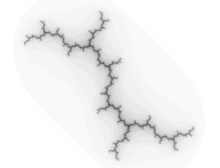Dendroid (topology)
In mathematics, a dendroid is a type of topological space, satisfying the properties that it is hereditarily unicoherent (meaning that every subcontinuum of X is unicoherent), arcwise connected, and forms a continuum.[1] The term dendroid was introduced by Bronisław Knaster lecturing at the University of Wrocław,[2] although these spaces were studied earlier by Karol Borsuk and others.[3][4]
Borsuk (1954) proved that dendroids have a fixed-point theorem: every continuous function from a dendroid to itself has a fixed point.[3] Cook (1970) proved that every dendroid is tree-like, meaning that it has arbitrarily fine open covers whose nerve is a tree.[1][5] The question of whether more generally every tree-like continuum has a fixed-point theorem, posed by Bing (1951) [6] has been solved by David P. Bellamy [7]
In Knaster's original publication on dendroids, in 1961, he posed the problem of characterizing the dendroids that can be embedded into the Euclidean plane, which also remains open.[2][8] Another problem posed in the same year by Knaster, on the existence of an uncountable collection of dendroids with the property that no dendroid in the collection has a continuous surjection onto any other dendroid in the collection, was solved by Minc (2010) and Islas (2007).[9][10]
A locally connected dendroid is called a dendrite. A cone over the Cantor set (called a Cantor fan) is an example of a dendroid that is not a dendrite.[11]
References
- 1 2 Cook, H. (1995), Continua: With the Houston Problem Book, Lecture Notes in Pure and Applied Mathematics, 170, CRC Press, p. 31, ISBN 9780824796501
- 1 2 Charatonik, Janusz J. (1997), "The works of Bronisław Knaster (1893–1980) in continuum theory", Handbook of the history of general topology, Vol. 1, Dordrecht: Kluwer Acad. Publ., pp. 63–78, MR 1617581.
- 1 2 Borsuk, K. (1954), "A theorem on fixed points", Bulletin de l’Académie polonaise des sciences. Classe troisième., 2: 17–20.
- ↑ Lelek, A (1961), "On plane dendroids and their end points in the classical sense" (PDF), Fund. Math., 49: 301–319.
- ↑ Cook, H. (1970), "Tree-likeness of dendroids and λ-dendroids", Fundamenta Mathematicae, 68: 19–22, MR 0261558.
- ↑ Bing, R. H. (1951), "Snake-like continua", Duke Mathematical Journal, 18: 653–663, doi:10.1215/s0012-7094-51-01857-1, MR 0043450.
- ↑ Bellamy, David P. (1980), "A tree-like continuum without the fixed-point property", Houston J. Math., 6: 1–13, MR 0575909.
- ↑ Martínez-de-la-Vega, Veronica; Martínez-Montejano, Jorge M. (2011), "Open problems on dendroids", in Pearl, Elliott M., Open Problems in Topology II, Elsevier, pp. 319–334, ISBN 9780080475295. See in particular p. 331.
- ↑ Minc, Piotr (2010), "An uncountable collection of dendroids mutually incomparable by continuous functions", Houston Journal of Mathematics, 36 (4): 1185–1205, MR 2753740. Previously announced in 2006.
- ↑ Islas, Carlos (2007), "An uncountable collection of mutually incomparable planar fans", Topology Proceedings, 31 (1): 151–161, MR 2363160.
- ↑ Charatonik, J.J.; Charatonik, W.J.; Miklos, S. (1990). "Confluent mappings of fans". Dissertationes Mathematicae. 301: 1–86.
